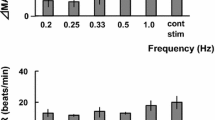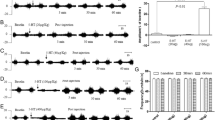Abstract
Nifedipine is a therapeutic drug in acute attacks of hypertension because of its rapid absorption from oral mucosa. Taste receptors are innervated by glossopharyngeal nerves (GPN) as well as by facial and vagal nerves. Sensory neurons of the GPNs are localised in the petrous ganglion (PG). Transection of the taste sensitive GPN fibres causes taste bud and PG degeneration and spontaneous hypertension. In this study, the role of chemical stimulation of the taste buds of the GPN by nifedipine and its role in treatment of hypertension were investigated in rabbits. Nifedipine was dropped sublingually (20 mg) for 4 days in the study group, followed by measuring blood pressures again. Then, the lingual branches of GPNs were cut. One month later, blood pressures were measured for 4 days. All animals were sacrificed humanely at the end of the experiment, and normal and degenerated neuron densities in the petrosal ganglions were enumerated stereologically. The antihypertensive effect of nifedipine decreased after GPNs denervation, in accordance with the increase of degenerated neurons in the PG. The chemical stimulation of taste buds of the GPNs by nifedipine may be an important effect of nifedipine application in addition to its calcium channel blocking effect. The rapid decrease in blood pressure following sublingual use of nifedipine may also result from the direct stimulation of taste buds innervated by the GPNs.
Similar content being viewed by others
References
Aydin, M. D., Bayram, E., Atalay, C., Aydin, N., Erdogan, A. R., Gundogdu, C. et al., The role of neuron numbers of the petrosal ganglion in the determination of blood pressure: an experimental study. Minim. Invasive Neurosurg., 49, 359–361(2006).
Beckett, A. H. and Moffat, A. C., The buccal absorption of some barbiturates. J. Pharm. Pharmacol., 23, 15–18 (1971).
Beckett, A. H. and Triggs, E. J., Buccal absorption of basic drugs and its application as an in vivo model of passive drug transfer through lipid membranes. J. Pharm. Pharmacol., 19, 41–45 (1967).
Belecky, T. L. and Smith, D. V., Postnatal development of palatal and laryngeal taste buds in the hamster. J. Comp. Neurol., 293, 646–654 (1990).
Berry, M. S. and Pentreath, V. W., Criteria for distinguishing between monosynaptic and polysynaptic transmission. Brain Res., 105, 1–20 (1976).
Bradley, R. M., Mistretta, C. M., Bates, C. A., and Killackey, H. P., Transganglionic transport of HRP from the circumvallate papilla of the rat. Brain Res., 361, 154–161(1985).
Czupryniak, L. and Loba, J., Loss of taste-induced hypertension—caveat for taste modulation as a therapeutic option in obesity. Eat. Weight Disord., 12, 11–13 (2000).
Dali, M. M., Paul, A. M., Mathias, N. R., Paul, I. S., Christopher, L. H., and Ronald, L. S., A rabbit model for sublingual drug delivery: Comparison with human pharmacokinetic studies of propranolol, verapamil and captopril. J. Pharm. Sci., 95, 37–44 (2006).
Formaker, B. K. and Hill, D. L., Lack of amiloride sensitivity in SHR and WKY glossopharyngeal taste responses to NaCl. Physiol. Behav., 50, 765–769 (1991).
Guth, L., The effects of glossopharyngeal nerve transection on the circumvallate papilla of the rat. Anat. Rec., 128, 715–731 (1957).
Hamilton, R. B. and Norgren, R., Central projections of gustatory nerves in the rat. J. Comp. Neurol., 222, 560–577 (1984).
Hasso, S., Pharmacological aspects of calcium channel blockers. Cardiovasc. Drugs Ther., 10, 869–872 (1997).
Hosley, M. A., Hughes, S. E., Morton, L. L., and Oakley, B. A., sensitive period for the neural induction of taste buds. J. Neurosci., 7, 2075–2080 (1987).
Huang, Y. J. and Lu, K. S., Tunnel staining and electron microscopy studies of apoptotic changes in the guinea pig vallate taste cells after unilateral glossopharyngeal denervation. Anat. Embryol., 204, 493–501 (2001).
Lewkowski, M. D., Ditto, B., Roussos, M., and Young, S. N., Sweet taste and blood pressure-related analgesia. Pain, 106, 181–186 (2003).
Motwani, J. G. and Lipworth, B. J., Clinical pharmacokinetics of drug administered buccally and sublingually. Clin. Pharmacokinet., 21, 83–94 (1991).
Noda, T., Yaginuma., O’Rourke, M. F., and Hosoda, S., Effects of nifedipine on systemic and pulmonary vascular impedance in subjects undergoing cardiac catheterization. Hypertens. Res., 29, 505–513 (2006).
Oakley, B., On the specification of taste neurons in the rat tongue. Brain Res., 75, 85–96 (1974).
Squier., C. A. and Wertz, P. W., Structure and function of the oral mucosa and implications for drug delivery. In: Rathbone MJ, editor. Oral mucosal drug delivery. Marcel Dekker Inc., New York, pp. 1–26, (1996).
Squier, C. A. and Johnson, N. W., Permeability of oral mucosa. Br. Med. Bull., 31, 169–175 (1975).
Whitehead, M. C., Anatomy of the gustatory system in the hamster: synaptology of facial afferent terminals in the solitary nucleus. J. Comp. Neurol., 244, 72–85 (1986).
Author information
Authors and Affiliations
Corresponding author
Rights and permissions
About this article
Cite this article
Aydin, M.D., Bayram, E., Halici, Z. et al. Antihypertensive role of glossopharyngeal nerve stimulation by nifedipine using as calcium channel blocking agent in hypertension: An experimental study. Arch. Pharm. Res. 32, 1607–1611 (2009). https://doi.org/10.1007/s12272-009-2114-0
Received:
Revised:
Accepted:
Published:
Issue Date:
DOI: https://doi.org/10.1007/s12272-009-2114-0




